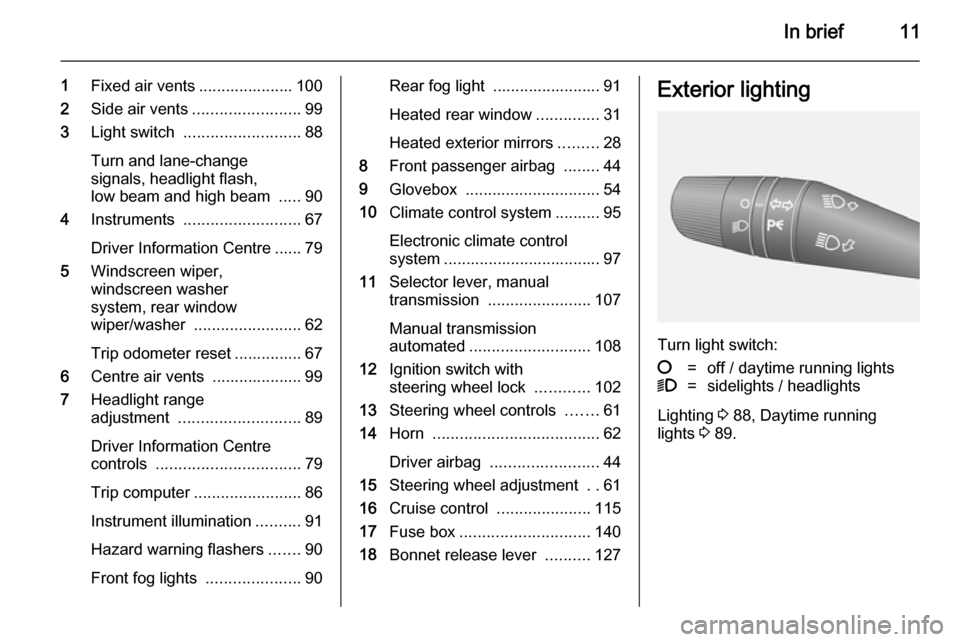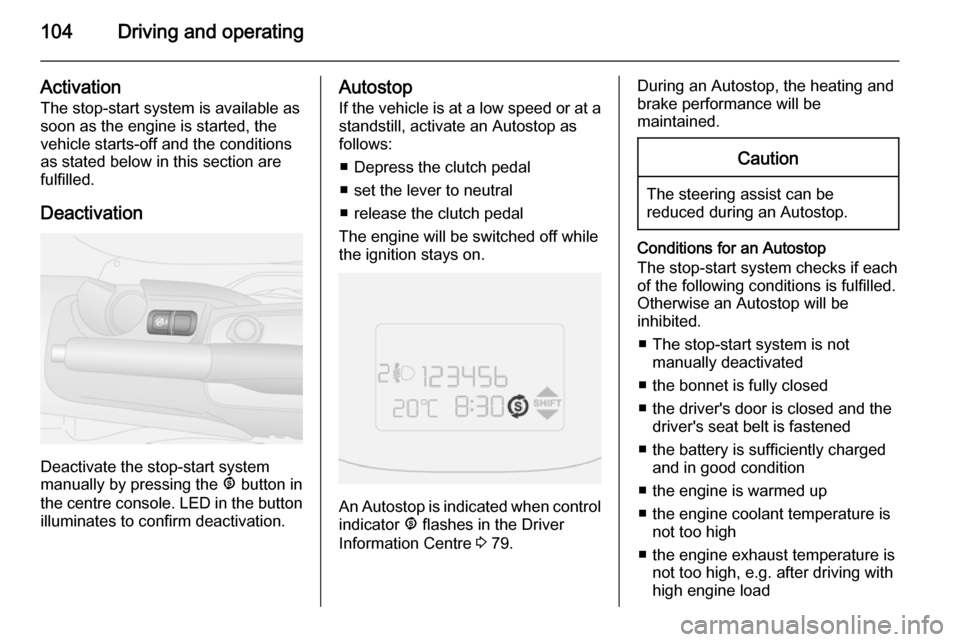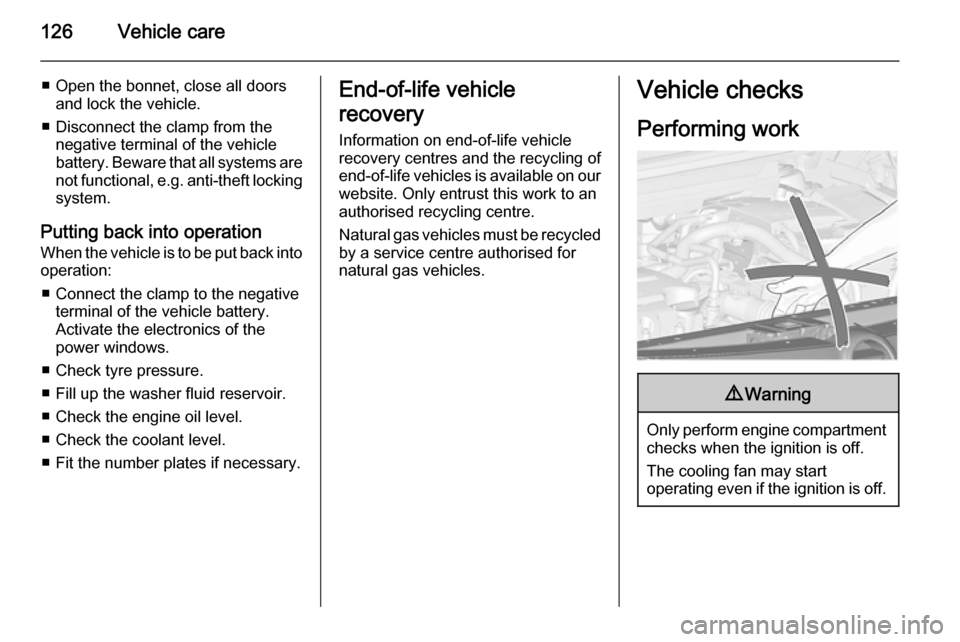bonnet VAUXHALL COMBO 2014 Owner's Manual
[x] Cancel search | Manufacturer: VAUXHALL, Model Year: 2014, Model line: COMBO, Model: VAUXHALL COMBO 2014Pages: 187, PDF Size: 4.15 MB
Page 13 of 187

In brief11
1Fixed air vents ..................... 100
2 Side air vents ........................ 99
3 Light switch .......................... 88
Turn and lane-change
signals, headlight flash,
low beam and high beam .....90
4 Instruments .......................... 67
Driver Information Centre ...... 79
5 Windscreen wiper,
windscreen washer
system, rear window
wiper/washer ........................ 62
Trip odometer reset ............... 67
6 Centre air vents .................... 99
7 Headlight range
adjustment ........................... 89
Driver Information Centre
controls ................................ 79
Trip computer ........................ 86
Instrument illumination ..........91
Hazard warning flashers .......90
Front fog lights .....................90Rear fog light ........................ 91
Heated rear window ..............31
Heated exterior mirrors .........28
8 Front passenger airbag ........44
9 Glovebox .............................. 54
10 Climate control system .......... 95
Electronic climate control
system ................................... 97
11 Selector lever, manual
transmission ....................... 107
Manual transmission
automated ........................... 108
12 Ignition switch with
steering wheel lock ............102
13 Steering wheel controls .......61
14 Horn ..................................... 62
Driver airbag ........................ 44
15 Steering wheel adjustment ..61
16 Cruise control .....................115
17 Fuse box ............................. 140
18 Bonnet release lever ..........127Exterior lighting
Turn light switch:
§=off / daytime running lights9=sidelights / headlights
Lighting 3 88, Daytime running
lights 3 89.
Page 106 of 187

104Driving and operating
ActivationThe stop-start system is available as
soon as the engine is started, the
vehicle starts-off and the conditions
as stated below in this section are
fulfilled.
Deactivation
Deactivate the stop-start system
manually by pressing the ^ button in
the centre console. LED in the button
illuminates to confirm deactivation.
Autostop
If the vehicle is at a low speed or at a
standstill, activate an Autostop as
follows:
■ Depress the clutch pedal
■ set the lever to neutral
■ release the clutch pedal
The engine will be switched off while the ignition stays on.
An Autostop is indicated when control indicator ^ flashes in the Driver
Information Centre 3 79.
During an Autostop, the heating and
brake performance will be
maintained.Caution
The steering assist can be
reduced during an Autostop.
Conditions for an Autostop
The stop-start system checks if each
of the following conditions is fulfilled.
Otherwise an Autostop will be
inhibited.
■ The stop-start system is not manually deactivated
■ the bonnet is fully closed
■ the driver's door is closed and the driver's seat belt is fastened
■ the battery is sufficiently charged and in good condition
■ the engine is warmed up
■ the engine coolant temperature is not too high
■ the engine exhaust temperature is not too high, e.g. after driving with
high engine load
Page 128 of 187

126Vehicle care
■ Open the bonnet, close all doorsand lock the vehicle.
■ Disconnect the clamp from the negative terminal of the vehicle
battery. Beware that all systems are not functional, e.g. anti-theft lockingsystem.
Putting back into operation When the vehicle is to be put back into
operation:
■ Connect the clamp to the negative terminal of the vehicle battery.
Activate the electronics of the
power windows.
■ Check tyre pressure.
■ Fill up the washer fluid reservoir.
■ Check the engine oil level.
■ Check the coolant level.
■ Fit the number plates if necessary.End-of-life vehicle
recovery
Information on end-of-life vehicle
recovery centres and the recycling of
end-of-life vehicles is available on our website. Only entrust this work to an
authorised recycling centre.
Natural gas vehicles must be recycled by a service centre authorised for
natural gas vehicles.Vehicle checks
Performing work9 Warning
Only perform engine compartment
checks when the ignition is off.
The cooling fan may start
operating even if the ignition is off.
Page 129 of 187

Vehicle care1279Danger
The ignition system use extremely
high voltage. Do not touch.
Bonnet
Opening
Pull the release lever and return it to
its original position.
Push the safety catch and open the
bonnet.
Secure the bonnet support.
If the bonnet is opened during an
Autostop, the engine will be restarted automatically for safety reasons.
Stop-start system 3 103.
Closing Lower the bonnet and allow it to drop
into the catch. Check that the bonnet
is engaged.
Engine oil
Check the engine oil level manually
on a regular basis to prevent damage
to the engine. Ensure that the correct specification of oil is used.
Recommended fluids and lubricants
3 159.
Check with the vehicle on a level
surface. The engine must be at
operating temperature and switched
off for at least 5 minutes.
Pull out the dipstick, wipe it clean, insert it to the stop on the handle, pull
out and read the engine oil level.
Page 157 of 187

Vehicle care155Appearance care
Exterior care
Locks The locks are lubricated at the factoryusing a high quality lock cylinder
grease. Use de-icing agent only when
absolutely necessary, as this has a
degreasing effect and impairs lock function. After using de-icing agent,
have the locks regreased by a
workshop.
Washing The paintwork of your vehicle is
exposed to environmental influences.
Wash and wax your vehicle regularly.
When using automatic vehicle
washes, select a programme that
includes waxing.
Bird droppings, dead insects, resin,
pollen and the like should be cleaned off immediately, as they contain
aggressive constituents which can
cause paint damage.If using a vehicle wash, comply with
the vehicle wash manufacturer's
instructions. The windscreen wiper
and rear window wiper must be
switched off. Remove antenna and
external accessories such as roof
racks etc.
If you wash your vehicle by hand,
make sure that the insides of the
wheel housings are also thoroughly
rinsed out.
Clean edges and folds on opened
doors and the bonnet as well as the
areas they cover.Caution
Always use a cleaning agent with
a pH value of 4 to 9.
Do not use cleaning agents on hot surfaces.
Have the door hinges of all doors
greased by a workshop.
Do not clean the engine compartment with a steam-jet or high-pressure jet
cleaner.
Thoroughly rinse and leather-off the vehicle. Rinse leather frequently. Use
separate leathers for painted and
glass surfaces: remnants of wax on
the windows will impair vision.
Exterior lights
Headlight and other light covers are
made of plastic. Do not use any
abrasive or caustic agents, do not use an ice scraper, and do not clean them
dry.
Polishing and waxing Wax the vehicle regularly (at the
latest when water no longer beads).
Otherwise, the paintwork will dry out.
Polishing is necessary only if the paint
has become dull or if solid deposits
have become attached to it.
Paintwork polish with silicone forms a
protective film, making waxing
unnecessary.
Plastic body parts must not be treated with wax or polishing agents.
Page 182 of 187

180IndexAAccessories and vehicle modifications .......................... 125
Adjustable air vents .....................99
Airbag activation ........................... 79
Airbag and belt tensioners ...........73
Airbag deactivation ..........45, 74, 79
Airbag system .............................. 41
Air conditioning regular operation ................................ 100
Air conditioning system ................ 96
Air intake .................................... 100
Air vents........................................ 99
Alert .............................................. 85
Antilock brake system ................ 112
Antilock brake system (ABS) .......75
Anti-Slip Regulator (ASR) ...........113
Anti-theft locking system .............. 26
Appearance care ........................155
Armrest ......................................... 35
Ashtrays ....................................... 67
ASR (Anti-Slip Regulator) ...........113
Audible warning chimes................ 85
Autoclose ...................................... 79
Automatic fuel cut-off ............85, 103
Automatic locking .........................79B
Battery ....................................... 130
Battery discharge protection ........94
Belts.............................................. 38 Bonnet ....................................... 127
Brake and clutch fluid .................159
Brake assist ............................... 113
Brake fluid .................................. 130
Brake pad wear ............................ 75
Brakes ............................... 112, 130
Brake system ............................... 74
Breakdown.................................. 153
Bulb replacement ....................... 132
C Capacities .................................. 173
Car Pass ...................................... 19
Catalytic converter .....................107
Central locking system ................21
Centre high-mounted brake light 135
Change engine oil .......................77
Changing tyre and wheel size ...144
Charging system .......................... 74
Child locks ................................... 22
Child restraint installation locations ................................... 49
Child restraints.............................. 47
Child restraint systems ................47